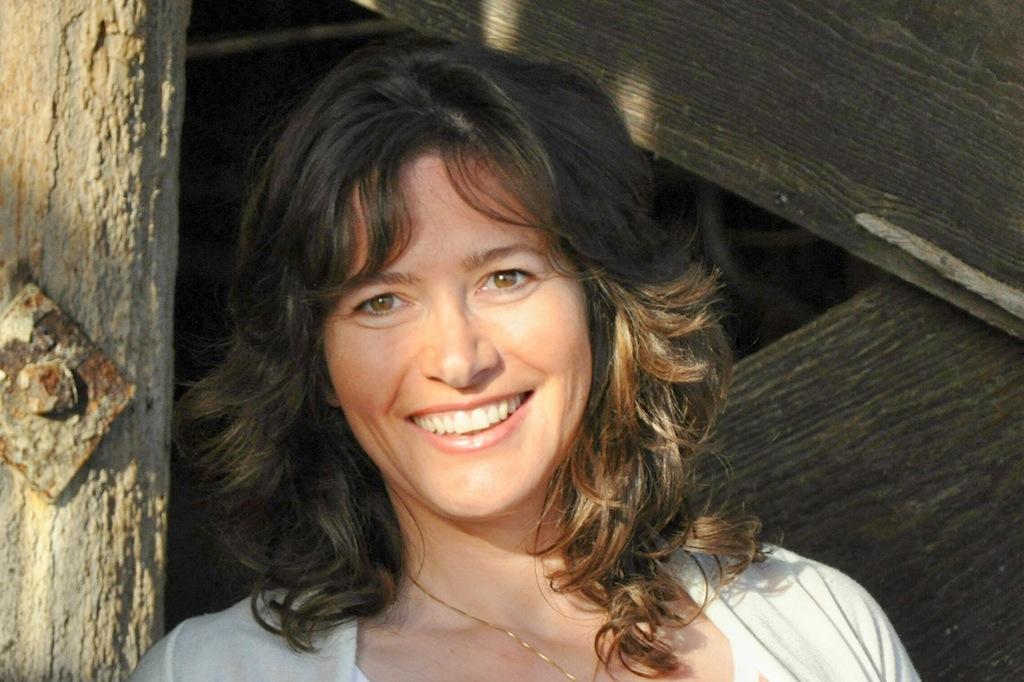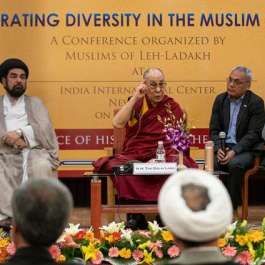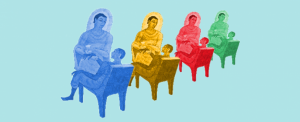Bent on enlightenment, wrathful and playful, a dakini seduces, wills, and tugs practitioners toward wisdom. Dakini Power, a recent book by German journalist Michaela Haas, explores the feminine dakini ideal as a force for institutional change. In a historically male hierarchy, modern female teachers are transforming Tibetan Buddhism, tugging it toward greater acknowledgement of female ability and accomplishment.
Haas interviewed twelve of the most influential female teachers and figures in Tibetan Buddhism, from princesses in exile to hermits, consorts, and the founders of abbeys around the world. Some, such as Pema Chödrön, are familiar voices for Western practitioners; others, such as Jetsun Khandro Rinpoche, cross boundaries between Tibetan and American audiences. All these teachers share something in common, Haas asserts: they prove that women can and do have a role at the highest levels of Tibetan Buddhism.
Each chapter forms a mini-biography of one woman. Haas spent time with almost all the teachers, and relies on primary interviews. Those now deceased or in retreat have their stories knitted together from previously published writings. With a focus on the human side, Haas treats her subjects as women struggling with institutional injustice. Her goal is to inspire, but also to discuss sexism and the religious glass ceiling. The book therefore has an assertive thesis, tinged with feminism but grounded in the real-life experience of these women as religious warriors.
She’s mostly successful. The volume is remarkably simple in its scope: twelve of the world’s greatest female practitioners come to life in its pages, sharing their stories—their initiation into Buddhism; their struggles to marry, remain celibate, or embrace seclusion; and their frustrations in bringing
Buddhism to the West. All have ties to America. A remarkable number of them grew up in the US, traveled to Nepal, Tibet, or India on a pilgrimage, and stayed, entranced and compelled by the foreign culture to make Buddhism their path.
Many encountered a male-dominated, male-focused hierarchy that they found difficult to tolerate. All have found ways to challenge or interpret the tradition—some more directly than others. Dagmola Kusho Sakya, one of the few Tibetan women in the book, faced exile from her home country with grace, finding a new role in new circumstances: “Dagmola readily admits that if she had stayed in Tibet, she probably would never have started teaching. ‘In Tibet, they respect yoginis very much, but people want teaching from the lamas,’ she says humbly. ‘With so many great teachers around, what did I have to add?’”
The Western women tend to more directly comment on the sexism they have encountered. Karma Lekshe Tsomo, originally from California, now advocates for education for nuns in Tibet. “If women are perpetually disadvantaged, [poverty] is what you end up with. Surveys show that the nuns’ health is by far the worst of any group. Their educational standards are by far the worst too. There is a lot of work to be done,” she comments.
These women’s roles are both political and religious, challenging tradition while maintaining and transmitting it to a new generation of Western practitioners. Their advocacy raises an important question, which Haas could perhaps have spent more time investigating: What is the role of a Western practitioner in a non-Western practice? Largely because the book focuses on transmissions in the West and because the US has tended to cultivate more outspoken female leaders than Tibet has, the women in the book are mostly white Americans. For a woman fighting for equality in an adopted culture, where is the line between standing up for yourself and insisting on your own cultural norms? What of a religion do we accept on faith, as part of the package, and what do we question, resist, or even refuse? The women of Dakini Power walk that line, thoughtfully and insistently.
One of the most insightful commentaries on this dichotomy comes from Thubten Chodron, who leads Sravasti Abbey in Washington. “For many years I tried to act like the Tibetan nuns: shy, self-effacing, sweet—but it didn’t work,” she reflects. “I am a college-educated person from the West who had a career. I had to accept myself as such and use my talents instead of pretending to be something else.”
The gender roles seem most fraught in discussion of the controversial sexual relationships within Tibetan Buddhism. Sex between a master and student occurs with some regularity in the tradition; allegations of abuse have tainted what some see as yet another path to enlightenment. The women in Dakini Power disagree about sex, with some speaking out against abuse and others cautioning against universal condemnation of sexual practices. While Haas doesn’t linger on the issue, she notes discomfort and outright resistance from many of the teachers toward sexual practices.
Haas writes in a crisp, clear style. Her prose interweaves descriptions of the women with snippets of their biographies and long quotations. It’s pleasant reading—well sourced and factual, but rooted in the heart. Haas admits that her “interest is personal,” deliberately separating the volume from her journalistic work.
At times, her partiality to her subjects makes her indecisive about how to portray them. Haas’s desire to frankly discuss their very human frustrations and foibles sometimes clashes with her sense of veneration. She zooms in on the women, then backs away suddenly, as if keeping a respectful distance. Her supporting research outlines each teacher’s beliefs, but much of it is reprinted from the teachers’ previous books and lectures. Less intimate than the one-on-one interviews, these quotations tend to create distance rather than depth. Haas is at her best when describing the woman in front of her: “Like a high-powered, nimble, compact car, Khandro Rinpoche glides through the Verizon Center in Washington, DC at top speed.” It’s an unexpected and therefore vivid comparison.
Overall, the book succeeds in opening up a conversation about the shape of Tibetan Buddhism in the West and the historical and expanding role of women. Discussion of gender, sex, and power is inevitable when any ancient religion seeks a foothold in a new culture—and Haas has made a valuable opening statement in what we can hope will be an ongoing conversation.
Dakini Power by Michaela Haas was published by Snow Lion in 2013. It is also available as an eBook.













